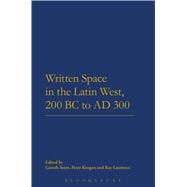This volume explores the creation of 'written spaces' through the accretion of monumental inscriptions and non-official graffiti in the Latin-speaking West between c.200 BC and AD 300. The shift to an epigraphic culture demonstrates new mentalities regarding the use of language, the relationship between local elites and the population, and between local elites and the imperial power. The creation of both official and non-official inscriptions is one of the most recognisable facets of the Roman city. The chapters of this book consider why urban populations created these written spaces and how these spaces in turn affected those urban civilisations. They also examine how these inscriptions interacted to create written spaces that could inculcate a sense of 'Roman-ness' into urban populations whilst also acting as a means of differentiating communities from each other. The volume includes new approaches to the study of political entities, social institutions, graffiti and painting, and the differing trajectories of written spaces in the cities of Roman Africa, Italy, Spain and Gaul.

Written Space in the Latin West, 200 Bc to Ad 300
by Sears, Gareth; Keegan, Peter; Laurence, RayBuy New
Rent Textbook
Rent Digital
Downloadable: 180 Days
Downloadable: 365 Days
Downloadable: Lifetime Access
Used Textbook
We're Sorry
Sold Out
This item is being sold by an Individual Seller and will not ship from the Online Bookstore's warehouse. The Seller must confirm the order within two business days. If the Seller refuses to sell or fails to confirm within this time frame, then the order is cancelled.
Please be sure to read the Description offered by the Seller.
Summary
Author Biography
Peter Keegan is a Senior Lecturer in Roman History at Macquarie University, Australia.
Ray Laurence is Professor of Roman History and Archaeology at the University of Kent, UK.
Table of Contents
2. Writing In Roman Public Space - Corbier
3. Writing In Public Space: The Meaning of Graffiti - Laurence and Senna-Garrafoni
4. The Political Graffiti of the Late Roman Republic - Hillard
5. Slaves and Children in a Roman Villa: Writing and Space in the Villa di San Marco at Stabiae - Laurence, Baldwin and Moulden
6. Convergence and Commentary: Writing at the Locus Celeberrimus -Newsome
7. Reconstructing the Epigraphic Culture of Funerary Space in the Roman City - Keegan
8. Looking at Inscriptions in Roman Baths - Cooley
9. Text, Space, and Movement: Discovering the Platea in Epigraphy - Trifilo
10. Inscribed in the City: How Did Women Enter Written Space? - Hemelrijk
11. Calendars: Time in Written Spaces - Hannah
12. A New Era? The Function of Severan Inscriptions in Africa - Sears
13. The City as Preferred Epigraphic Space: The Case of Aquitania - Esmonde-Cleary
14. Writing Politics in the Western Mediterranean - Revell
15. Afterword - Keegan.
An electronic version of this book is available through VitalSource.
This book is viewable on PC, Mac, iPhone, iPad, iPod Touch, and most smartphones.
By purchasing, you will be able to view this book online, as well as download it, for the chosen number of days.
A downloadable version of this book is available through the eCampus Reader or compatible Adobe readers.
Applications are available on iOS, Android, PC, Mac, and Windows Mobile platforms.
Please view the compatibility matrix prior to purchase.
